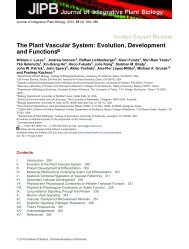Roles of SNARE Proteins in Synaptic Vesicle Fusion - Department of ...
Roles of SNARE Proteins in Synaptic Vesicle Fusion - Department of ...
Roles of SNARE Proteins in Synaptic Vesicle Fusion - Department of ...
You also want an ePaper? Increase the reach of your titles
YUMPU automatically turns print PDFs into web optimized ePapers that Google loves.
42 M.T. Palfreyman, E.M. Jorgensen<br />
A Model for Membrane <strong>Fusion</strong><br />
Membranes do not spontaneously fuse, because <strong>of</strong> the high repulsive forces between<br />
two phospholipid bilayers 1 to 2 nm apart. How might the <strong>SNARE</strong>s fuse membranes?<br />
Three characteristics <strong>of</strong> the <strong>SNARE</strong>s are central to the current models for<br />
their function <strong>in</strong> fus<strong>in</strong>g membranes. First, the assembled <strong>SNARE</strong> complex is<br />
remarkably stable. The formation <strong>of</strong> the <strong>SNARE</strong> complex is therefore an energy<br />
source that can be used to overcome barriers to fusion. Second, the <strong>SNARE</strong> complex<br />
must consist <strong>of</strong> at least two <strong>SNARE</strong> molecules with transmembrane doma<strong>in</strong>s (84).<br />
The transmembrane doma<strong>in</strong>s must be <strong>in</strong>serted <strong>in</strong>to both <strong>of</strong> the membranes dest<strong>in</strong>ed<br />
to fuse (54). Third, the <strong>SNARE</strong>s assemble <strong>in</strong> a parallel orientation (44,78,79,85).<br />
Due to the parallel orientation <strong>of</strong> the <strong>SNARE</strong> motifs, <strong>SNARE</strong> assembly leads to the<br />
close apposition <strong>of</strong> the transmembrane doma<strong>in</strong>s and hence the membranes themselves.<br />
This section describes how the assembly <strong>of</strong> the <strong>SNARE</strong> complexes might<br />
lead the membranes through the sequential <strong>in</strong>termediates <strong>of</strong> a lipid stalk, a hemifusion<br />
diaphragm, an <strong>in</strong>itial fusion pore, and f<strong>in</strong>ally full fusion (Fig. 3.3).<br />
The stability <strong>of</strong> the <strong>SNARE</strong> complexes comb<strong>in</strong>ed with their parallel orientation<br />
led to the idea that their formation might provide the driv<strong>in</strong>g force for fusion. By first<br />
assembl<strong>in</strong>g at their N-term<strong>in</strong>als and subsequently “zipper<strong>in</strong>g” down to their membrane<br />
proximal C-term<strong>in</strong>als, the assembly <strong>of</strong> the <strong>SNARE</strong>s would br<strong>in</strong>g the transmembrane<br />
doma<strong>in</strong>s <strong>of</strong> synaptobrev<strong>in</strong> and syntax<strong>in</strong> <strong>in</strong>to close proximity (77–79, 86–88)<br />
(Fig. 3.2). Evidence for zipper<strong>in</strong>g comes from two complementary experiments.<br />
First, biochemical and structural studies have shown that the membrane proximal<br />
doma<strong>in</strong> <strong>of</strong> syntax<strong>in</strong> becomes sequentially more ordered upon b<strong>in</strong>d<strong>in</strong>g synaptobrev<strong>in</strong><br />
<strong>in</strong> a directed N- to C-term<strong>in</strong>al fashion (55,57,87,89). The temperatures for assembly<br />
and disassembly <strong>of</strong> <strong>SNARE</strong> complex differ by as much as 10°C. Thus, assembly and<br />
dissociation follow different reaction pathways. This hysteresis suggests a k<strong>in</strong>etic<br />
barrier between folded and unfolded states (45). Mutations <strong>in</strong> the N-term<strong>in</strong>al hydrophobic<br />
core <strong>of</strong> the <strong>SNARE</strong> complex selectively slowed <strong>SNARE</strong> assembly, while<br />
those <strong>in</strong> the C-term<strong>in</strong>al did not slow assembly (56,87), suggest<strong>in</strong>g that the N-term<strong>in</strong>al<br />
nucleates <strong>SNARE</strong> assembly. The k<strong>in</strong>etic barrier to assembly also suggests that loose<br />
<strong>SNARE</strong> complexes could be an <strong>in</strong>termediate.<br />
The second l<strong>in</strong>e <strong>of</strong> evidence for zipper<strong>in</strong>g comes from <strong>in</strong> vivo disruption studies<br />
us<strong>in</strong>g clostridial tox<strong>in</strong>s, antibodies directed toward the <strong>SNARE</strong> motifs, and mutations<br />
<strong>in</strong> the hydrophobic core <strong>of</strong> the <strong>SNARE</strong> complex (77,86–88,90). The tox<strong>in</strong> and<br />
antibody disruption studies demonstrated that the N-term<strong>in</strong>i <strong>of</strong> <strong>SNARE</strong>s become<br />
resistant to cleavage or antibody block at early stages, while C-term<strong>in</strong>i are only resistant<br />
to disruptions at late stages. As a specific example, Hua et al <strong>in</strong>jected either botul<strong>in</strong>um<br />
tox<strong>in</strong> D, which cleaves free synaptobrev<strong>in</strong> at the N-term<strong>in</strong>al side <strong>of</strong> the <strong>SNARE</strong><br />
motif, or botul<strong>in</strong>um tox<strong>in</strong> B, which cleaves synaptobrev<strong>in</strong> toward the C-term<strong>in</strong>al<br />
side <strong>of</strong> the <strong>SNARE</strong> motif (88). <strong>SNARE</strong>s cannot be cleaved once they have assembled<br />
<strong>in</strong>to the four helix <strong>SNARE</strong> complex (46). Exocytosis from the crayfish neuromuscular<br />
junction was not sensitive to cleavage at the N-term<strong>in</strong>us <strong>of</strong> the <strong>SNARE</strong> motif,<br />
suggest<strong>in</strong>g that this region was protected, presumably by the <strong>SNARE</strong> complex. By<br />
contrast, neurotransmitter release was blocked by cleavage at the C-term<strong>in</strong>us <strong>of</strong> the<br />
Wang_Ch03.<strong>in</strong>dd 42 5/15/2008 5:27:13 PM
















